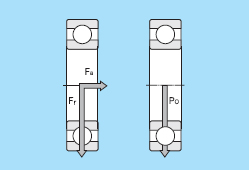Technical>Static bearing load

Static bearing load
 The basic static load rating “Co” is used in calculations when the bearings are to:
The basic static load rating “Co” is used in calculations when the bearings are to: - rotate at very slow speeds (n < 10 r/min).
- perform very slow oscillating movements.
- be stationary under load for certain extended periods.
It is also most important to check the safety factor of short duration loads such as shock or heavy peak loads that act on a bearing, whether it is rotating (dynamically stressed) or at rest.
● Static equivalent load
The static equivalent load is a hypothetical load which would cause the same total permanent deformation at the most heavily stressed contact point between the rolling elements and the raceway under the actual load conditions where both static radial load and static axial load are simultaneously applied to a bearing. For a radial bearing, this hypothetical load refers to pure radial load. For radial bearings the static equivalent radial load can be found by using formula below. The greater of the two resultant values is always taken for “Por ”.

Required basic static load rating
The basic static load rating is considered as the limiting load for general applications. In terms of a safety factor, this means that, by definition, a safety factor ”So” is set as a base of 1. An application may require a larger or allow a smaller safety factor provides a guide for selection of the safety factor ”So”, to be used with formula for calculation of the maximum (weighted) static equivalent load.

Guideline values for the static safety factor So
| Type of operation |
Rotating bearing Requirements regarding quiet running |
Non-rotating bearing | ||||||
| unimportant | normal | high | ||||||
| Ball bearing | Roller bearing | Ball bearing | Roller bearing | Ball bearing | Roller bearing | Ball bearing | Roller bearing | |
| Smooth, vibration-free | 0,5 | 1 | 1 | 1,5 | 2 | 3 | 0,4 | 0,8 |
| Normal | 0,5 | 1 | 1 | 1,5 | 2 | 3,5 | 0,5 | 1 |
| Pronounced shock loads | ≥1,5 | ≥2,5 | ≥1,5 | ≥3 | ≥2 | ≥4 | ≥1 | ≥2 |
Where the magnitude of the shock load is not known, values of ”So ” at least as large as those quoted above should be used. If the magnitude of the shock loads is exactly known, smaller values of ”So” can be applied.




